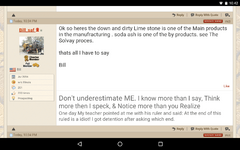Calling all "clay" hater's!!
Being a new miner, I've always been fascinated at the love/hate relationship between miner's and clay. They do the dance of joy when they find a layer of clay with a bounty of gold sitting right on top, or breaking through the false bedrock of clay and finding the payload there.
Only to curse the very same clay as they fight to combat it's relentless grip on gold and anything else that it comes into contact with! Even the most patient miner's cringe at the dreaded word "CLAY".
Here is what I have found so far.
There are many type's of clay. Which I AM NOT going to talk about because in terms of "fun", I'd rather stick an ice pick in my ear, then get that boring. I have found out that there are things that miner's add to clay, in an attempt to:
1. Settle the clay in the water faster in recirculating systems, to avoid pump burnout and run cleaner water.
2. Make clay release it's grip on our beloved gold and other valuables.
It's the first one that I need help with (to start with)! I want to run a recirculating system with a few tub's, and need advise on settling the clay in my water. I don't want any dangerous chemicals, and right now the best advise I have been given is 1/2 Borax, mixed with 1/2 Calgon Water Softener. The reason why I think this is good advise is because they are both, readily available, cheap, and safe to use.
Is there anyone out there that doesn't fear the dreaded CLAY, I really could use some advise, please!
Being a new miner, I've always been fascinated at the love/hate relationship between miner's and clay. They do the dance of joy when they find a layer of clay with a bounty of gold sitting right on top, or breaking through the false bedrock of clay and finding the payload there.
Only to curse the very same clay as they fight to combat it's relentless grip on gold and anything else that it comes into contact with! Even the most patient miner's cringe at the dreaded word "CLAY".
Here is what I have found so far.
There are many type's of clay. Which I AM NOT going to talk about because in terms of "fun", I'd rather stick an ice pick in my ear, then get that boring. I have found out that there are things that miner's add to clay, in an attempt to:
1. Settle the clay in the water faster in recirculating systems, to avoid pump burnout and run cleaner water.
2. Make clay release it's grip on our beloved gold and other valuables.
It's the first one that I need help with (to start with)! I want to run a recirculating system with a few tub's, and need advise on settling the clay in my water. I don't want any dangerous chemicals, and right now the best advise I have been given is 1/2 Borax, mixed with 1/2 Calgon Water Softener. The reason why I think this is good advise is because they are both, readily available, cheap, and safe to use.
Is there anyone out there that doesn't fear the dreaded CLAY, I really could use some advise, please!
Upvote
0












